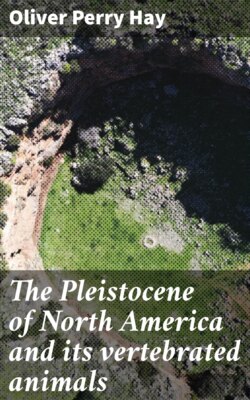Читать книгу The Pleistocene of North America and its vertebrated animals - Oliver Perry Hay - Страница 14
На сайте Литреса книга снята с продажи.
IX. Did the Extinction of Species Take Place Mostly at the End of the Pleistocene?
ОглавлениеTable of Contents
At the beginning of the Pleistocene there existed, as has been shown, an abundant and highly varied mammalian fauna; at the close of the epoch this fauna had become relatively impoverished. Did all those families and genera and species, that in the end were missing, perish during or after the last glacial stage, the Wisconsin? This opinion has been expressed by some. The writer believes that this view is wholly improbable.
A glacial sheet, stretched across the continent or a large part of it, was not local in its effects; it was not a cap of ice merely concealing a part of the land and covered possibly by forests and allowing occupation by certain hardy animals, while beyond, up to its foot, the country was pleasantly cool, wooded, and abounding with animated creatures. In the Sierra Nevada Mountains of California (Lindgren, Folio 66, U. S. Geol. Surv.) and of Nevada (Knopf, Prof. Pap., U. S. Geol. Surv., 110, pp. 92–105) and in the San Juan Mountains of Colorado (Atwood and Mather, Jour. Geol., vol. XX, p. 385), at distances of approximately 600 or 700 miles from the glacial front, there existed, during more than one stage, extensive local glaciers. Along the Atlantic coast during at least one glacial stage the walrus was driven as far south as Charleston, South Carolina. One can hardly doubt that the whole continent was chilled during each of the glacial stages.
To mammals, which for perhaps various reasons had been with difficulty enduring the stress of existence, the glacial climates would give the final stroke; perhaps to others the interglacial climates would have been quite as fatal. We can not doubt that each glacial and each interglacial stage swept away a few of the less hardy genera and species. Nevertheless, several remarkable animals passed through the vicissitudes of all the glacial and interglacial times and left their bones in the deposits overlying the last, or Wisconsin, drift. Such are two species of elephants, the American mastodon, the giant beaver, and one or more species of peccaries. Why they succumbed at last is difficult to say. Possibly the return of a fifth warm era proved too much for their endurance.
A reason for believing that the genera and species missing from the fauna found here when white men arrived, called sometimes the Columbian fauna, were exterminated gradually and not at one epoch is that certain ones are found in deposits overlying the earlier glacial drift-sheets, but are not found in deposits on later drifts. Camels occur in Aftonian beds overlying the Nebraskan drift, but have not been collected in later interglacial deposits. Horses grow scarcer as the Pleistocene advances. They are known from deposits overlying the Illinoian drift, but do not appear after the Wisconsin.
